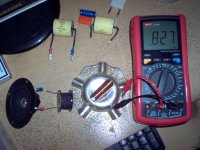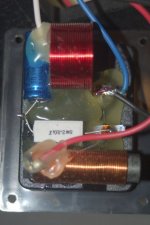There's a lot of speculative waffle at this forum about crossover components on quality and placement.
Yet when someone comes along with a measured and significant interaction from a surprising direction with a 1mH coil and a ground plane, you don't care! 20% change of value IS significant. As is the audible induced whine from the tweeter. 😕
Radio engineers have always been aware of parasitic effects between components and issues with earthing and circuit tracks. Shorting turns and metal in general near coils is bad. Many amps can be induced to flow.
I didn't find resistors or capacitors have much interaction whatsoever. but the below example of a commercial Monitor Audio crossover has a couple of obvious compromises due to space restrictions of being mounted on the speaker plugs mounting.
I would face the tweeter coil axis up for the right angle, which also moves that aluminium cased blue NP capacitor away from the coil throat where the magnetic field is strongest. It's a no brainer. It's a bit like a chess problem, a good player just SEES it instantly. 😎
Yet when someone comes along with a measured and significant interaction from a surprising direction with a 1mH coil and a ground plane, you don't care! 20% change of value IS significant. As is the audible induced whine from the tweeter. 😕
Radio engineers have always been aware of parasitic effects between components and issues with earthing and circuit tracks. Shorting turns and metal in general near coils is bad. Many amps can be induced to flow.
I didn't find resistors or capacitors have much interaction whatsoever. but the below example of a commercial Monitor Audio crossover has a couple of obvious compromises due to space restrictions of being mounted on the speaker plugs mounting.
I would face the tweeter coil axis up for the right angle, which also moves that aluminium cased blue NP capacitor away from the coil throat where the magnetic field is strongest. It's a no brainer. It's a bit like a chess problem, a good player just SEES it instantly. 😎
Attachments
Not sure whose post you're referencing but I certainly didn't say I didn't care, rather because most no one that builds there own speakers using a custom crossover uses a ground plane as the assembly base for the crossover, so it becomes a rather moot point, don't you think? The fact that the crossover in the commercial speaker you showed doesn't have an optimum component arrangement has no bearing on how I would build a crossover. I don't buy commercial speakers in the first place and don't give a hoot about how they might assemble their crossovers.
Paul
Edit: Please understand I'm not demeaning or dismissing the theoretical value of your input on the ground plane testing results, only that for the most part this is not going to be an issue as far as how most DIYers assemble their crossovers.
Paul
Edit: Please understand I'm not demeaning or dismissing the theoretical value of your input on the ground plane testing results, only that for the most part this is not going to be an issue as far as how most DIYers assemble their crossovers.
There's a lot of speculative waffle at this forum about crossover components on quality and placement.
Yet when someone comes along with a measured and significant interaction from a surprising direction with a 1mH coil and a ground plane, you don't care! 20% change of value IS significant. As is the audible induced whine from the tweeter. 😕
Radio engineers have always been aware of parasitic effects between components and issues with earthing and circuit tracks. Shorting turns and metal in general near coils is bad. Many amps can be induced to flow.
I didn't find resistors or capacitors have much interaction whatsoever. but the below example of a commercial Monitor Audio crossover has a couple of obvious compromises due to space restrictions of being mounted on the speaker plugs mounting.
I would face the tweeter coil axis up for the right angle, which also moves that aluminium cased blue NP capacitor away from the coil throat where the magnetic field is strongest. It's a no brainer. It's a bit like a chess problem, a good player just SEES it instantly. 😎
Last edited:
Thanks for the link on coil placement. I think this is probably the definitive test of the interaction. If there is no change in the measured inductance in these experiments, there can be no aural interaction between the coils that showed no increase or decrease in inductance.May be of interest: Placement of coils in crossover networks

